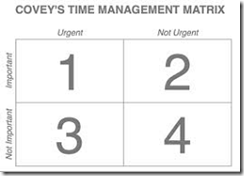 How big is your to do list? How big is your bucket list becoming? De-prioritization takes a different perspective, and it’s hard to do. Here are seven steps to stop doing what doesn’t matter.
How big is your to do list? How big is your bucket list becoming? De-prioritization takes a different perspective, and it’s hard to do. Here are seven steps to stop doing what doesn’t matter.
In life, emphasis is spent on learning what to do. Our parents, our teachers and our employers focus on the to do, not the what not to do.
However, people we perceive having fulfilled lives also have the smallest bucket lists. They are not anxious, but content. Companies with an innovative edge over competitors do not operate in reactive mode; they are agile in defining their future while spending little time responding to long to do lists with yesterday’s issues, fire drills and conflict.
Developing a systematic process for eliminating things from our to-do list might be valuable. It’s easy for business leaders to get caught up in the emotional attachment of tasks, activities and perceived priorities over pushing unnecessary projects and products aggressively onto the what not to do list.
We are not taught to instinctively identify those things that we should not do, or those things that we are doing that we should stop doing.
De-prioritization Framework to Maximize a Stop Doing List
Colloquially, instead of calling it “prioritizing in our to do list,” perhaps we should just be direct, and call the process: prioritizing out our NOT to do list?
We behave as if “more is better.” So, our to do lists get longer and stay long as we perpetually run out of time.
We often uses Covey’s four-box time management model: urgent vs. not urgent, and important vs. not important. Using the model, we work on our to do lists in order, but never feel empowered to actually NOT do what is not urgent, and not important. We instead naturally try to move things out of that fourth category into a group that we can spend time on doing.
Our use of this model fails when we are emotionally attached to tasks that we have put on our to do list. We hesitate to maximize the not urgent and not important box as we are measured by what we do. Further we don’t aggressively move things from box 4, to off the list entirely.
Box 4 should really have the longest list.
Steps to Radical De-prioritization
- Identify the top three things in your to do list.
- Prioritize those three things based on urgent and important.
- Put the most important and urgent task in box 1; Put the most important and not urgent task in box 2; Put the least important but urgent task in box 3.
- Put everything else on your to do list that didn’t make this cut, in box 4, and forget it for the duration of the day, or time it takes to complete the three tasks boxes 1, 2 and 3
- When tasks 1, 2, and 3 are done, reassess, adding any new tasks or objectives to the list.
- Deleting any of those in box 4 (the NOT to do list) that are now irrelevant.
- Repeat.
These are the mechanical steps. You still need to formally systematize the objective criterion for picking the three, and divesting all other tasks into list four. The framework is to give focus for applying immediate time and resources, and as more of the 1s, 2, and 3s are completed, the list in group 4 can move up, without distracting focus while completing the first three.
What To Stop Doing In Business
One form of “what not to do” list that leaders struggle with is divesting or executing end-of-life strategies on products. Rita Gunther McGrath, author of The End of Competitive Advantage, recently posted a video on HBR. She points out that there are 5 factors in achieving end of line of business success which I have expanded.
- Assign responsibility for putting things in the “don’t do” box, and measure performance against that objective.
- Break the culture of defending declining businesses for wrong, emotional, or special interest reasons that can be displaced by other objectives that strategically drive relatively more revenue and profit.
- Develop a rational system for evaluating activities and businesses that have declining value to take emotional, or most-favorite-client attachment to a product or service.
- Develop early warning sign indicators in your system of evaluation, evaluate all businesses equally, and have a standing executive agenda to assess businesses that exhibit the symptoms.
- Eliminate fear in the organization by redeploying people to new projects, before it is critical, thereby driving a culture of rejuvenation, renewal and replacement for products and services.
- Following these practices, and making them a part of your business culture is pivotal to keeping your business competitive.
More succinctly in terms that I use regularly, developing this kind of product do not do list is a significant competitive differentiator. It exposes the difference between market driven companies and market driving companies. Recall that market-driven companies are reactive to changes in the market apparent to anyone, and are by that nature, behind. And, recall that market driving companies are proactive in their agile pursuit of strategies to lead markets and customers to outcomes and solutions that deliver unexpected delight among users.
Building and executing the what not to do list in business, is difficult and sometimes painful. To ingrain it into culture is even more challenging. But the alternative to do everything on the to do list, is impossible. Netflix has shown that the will to build that list can even create public relations snafus. But their stock price shows how right they were to begin the transition away from DVD media and postal mailing content, toward their streaming business.
Applying Business Rules to Personal Goals
Rita’s rules also apply to your personal system for de-prioritization to maximizing focus on Covey’s box 1, 2 and 3, while at the same time, using box 4 to keep distractions from slowing progress on the top three priorities.
Reframing our perceived observation of others achieving their goals, they are more likely naturally and constantly executing a process of de-prioritization. Others waiting on the sidelines have failed to build the systematic approach and are waiting to be told what to do. The difference between those that deprioritize, and those that are paralyzed reminds me of the classic Pink Floyd song Time, with the line:
And then one day you find ten years have got behind you
No one told you when to run, you missed the starting gun
Use these rules and the four box model to evaluate and prioritize the things you don’t need to do to achieve your personal goals. Modify them to suit your personal need and style. Take emotion out of the equation, and do things for others that are balanced with the things you need to do first, to move your 1, 2 and 3 priority forward. It sounds selfish, but like putting your mask on before helping others around you, as our airline safety instructions tell us, is not about selfishness, but selflessness. We can only help others if we are strong in helping ourselves achieve our priorities with equal vigor.
To Ponder
Structuring this model both personally and professionally is not always a popular or well received approach. If you are depending on a task from another and it shows up in their box 4, be patient. Understand that they will get more done, and eventually get to your task.
What lines of business are you going to eliminate, and when? In both our personal and professional life, we cannot do it all. Can we instead use the Netflix example to drive our decisions to where we want to be?
Be proactive and build the list, and identify the triggers now, before the emotion and special interests fog the clarity of the decision. Think about where you will transfer your energy, resources, and your time execute your pervasive strategy.
In the ultimate end, your bucket list will be shorter, and fulfillment will be greater. Please leave a comment.
Image Credits: Big Dragline Bucket, John Nyberg









